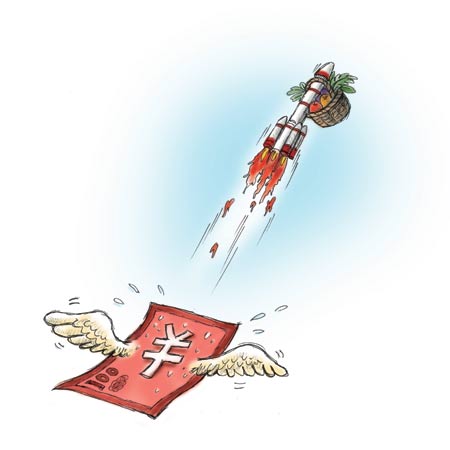CPI figures don't match realities of today's prices

Illustration: Liu Rui
People often remark that the price of goods is soaring like an eagle, but the official CPI data, which measures inflation, is creeping like a tortoise. These discrepancies are nothing new - when housing prices were skyrocketing, official statistics claimed that housing prices had only increased 1.5 percent from the previous year.
The historical data lets us draw some interesting conclusions about the effects of inflation. If we look at the official CPI figures, 100 yuan ($16) in 1978 should equal, in purchasing power, 519 yuan ($82) today. So, prices have only increased 4.2 times. But is this really the case?
In 1978, the average monthly salary of a Chinese household was 51.25 yuan ($8), which could support a family of three. At that time, a family which had 10,000 yuan in savings was very rich.
At the beginning of 2010, the average monthly household income was 2,728 yuan ($430), which, if we believe the CPI figures, would be equivalent in purchasing power to 525.6 yuan a month in 1978. So, compared to the average monthly salary of 51.25 yuan in 1978, salaries, adjusted for inflation, have increased almost tenfold.
According to the index, a monthly salary of 266 yuan now would have the same purchasing power of the average monthly salary of 51.25 yuan in 1978. But today 266 yuan ($42) is a mere two-thirds of the minimal assurance level for the poorest of Beijingers in 2010, which was 390 yuan ($62) a month.
Was this enough to support a family of three in 2010? Does the purchasing power of 10,000 yuan at the beginning of the reform and opening-up in 1978 only equal 51,900 yuan ($8,185) today?
In 1978, the monthly minimum for sustenance in Beijing was 7 yuan per person. Based on the CPI data, the purchasing power of 7 yuan in 1978 equals that of 36.33 yuan ($5.73) in 2010.
However, according to market surveys conducted by our researchers, 7 yuan in 1978 could buy 26.9 kilograms of rice or about 50 kilograms of vegetables or 4.12 kilograms of pork. It was enough for a month's careful eating for a typical household in Beijing.
Today, 36.33 yuan could buy 7.5 kilograms of ordinary rice or 2.5 kilograms of vegetables or 2 kilograms of pork. How many days could we live on such little stuff? It is less than a tenth of the minimum amount a family needs to support itself today.
In the past 30 years, apart from a few electronic goods, most consumer goods have increased in price. Generally speaking, they've gone up 20 or 30 times.
In 1978, most people rented publically owned apartments, while today, the purchase of homes has become a huge burden, as have education and medical fees. The extra burdens on families all factor into the expenses of everyday living, but they aren't taken proper account of by the CPI and other such measures.
Extrapolating from this, we can say that prices as a whole are about 20 to 22 times those of 1978. That is to say, the purchasing power of 100 yuan in 1978 would be equivalent to about 2,000 yuan ($315) to 2,200 yuan ($347) in 2010. Buying breakfast in 1978 only cost three to five fen (o.o3 to 0.05 yuan), but today it costs nearly two yuan. The same goes for bus rides. Taking into account the increase in household salaries, incomes have effectively, adjusted for inflation, increased by about 2.4 times.
Let's be honest, this growth rate is pretty good compared to other developing countries. But if we claim that Chinese workers are 10 times richer than they were in 1978, we just look ridiculous. We need clearer, more transparent, and more thorough statistical work, including a breakdown of how the figures were composed rather than simply a release of the final data, which just confuses people.
The author is a former researcher with the Chinese Academy of Sciences. opinon@globaltimes.com.cn
Three decades of change affects more than vegetables